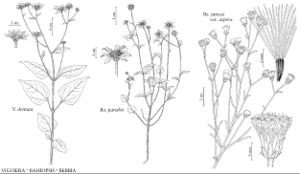Viguiera
in A. von Humboldt et al., Nov. Gen. Sp. 4(fol.): 176. 1818.
4(qto.): 224, plate 379. 1820.
| Taxon | Illustrator ⠉ | |
|---|---|---|
 | Viguiera dentata Bahiopsis parishii Bebbia juncea var. aspera | Marjorie C. Leggitt Marjorie C. Leggitt Barbara Alongi |
Perennials or shrubs [annuals], 50–200 cm. Stems erect or ascending, unbranched or branched. Leaves mostly cauline; opposite (proximal) and/or alternate (distal); petiolate or ± sessile; blades often 3-nerved (from at or near bases), deltate, deltate-ovate, lance-linear, lanceolate, lanceovate, linear, linear-filiform, rhombic-ovate, or ovate, sometimes pinnately lobed, ultimate margins entire or toothed, faces glabrous or hairy, often glanddotted. Heads radiate, borne singly or (2–25+) in open to crowded, ± corymbiform arrays. Involucres hemispheric [campanulate], (5–18 ×) 7–15 mm. Phyllaries persistent, 10–30 in 2–5 series (subequal to unequal). Receptacles flat to convex, paleate (paleae tan, conduplicate, apices often 3-lobed or toothed). Ray-florets 6–18, neuter; corollas yellow (laminae 2–4-lobed). Disc-florets 40–100+, bisexual, fertile; corollas yellow, tubes shorter than campanulate throats, lobes 5, triangular (style-branches slender, apices acute or attenuate). Cypselae (purplish black, often mottled) ± compressed, often obpyramidal (usually strigose, sometimes glabrous); pappi 0, or persistent or tardily falling, of 2 lacerate, aristate scales (2.2–5.5 mm) plus [0–] 2–4 [–6] lacerate or aristate scales (0.5–1.3 mm). x = 17.
Distribution
sw United States, Mexico, Central America, South America
Discussion
Species ca. 150 (3 in the flora).
Viguiera has been long recognized as paraphyletic. Molecular studies are helping to clarify its phylogeny, and the corresponding systematic adjustments are beginning (E. E. Schilling and J. L. Panero 2002). Some groups have already been separated, including Bahiopsis and Heliomeris. It is likely that the genus will be narrowed to include only a single species, V. dentata (including V. helianthoides Kunth), and that new or resurrected genera will accommodate the remaining species. As currently circumscribed, the genus occurs primarily in Mexico and South America and reaches its northern limit of distribution in the southwestern United States. The Mexican (Chihuahua, Durango) V. phenax was collected a single time in Texas [where it was named Helianthus ludens Shinners and Viguiera ludens (Shinners) M. C. Johnston]; it apparently has not become established in the flora area.
Selected References
Lower Taxa
Key
| 1 | Shrubs; leaves ovate (and shallowly to deeply lobed, lobes ± linear) or linear; pappi 0 | Viguiera stenoloba |
| 1 | Perennials; leaves deltate-ovate, lanceolate, lance-ovate, ovate, or rhombic-ovate (not lobed); pappi usually of 2 lacerate, aristate scales (2.2–5.5 mm) plus 2–4 lacerate or aristate scales (0.5–1.3 mm) | > 2 |
| 2 | Petioles 10–55 mm; phyllary apices abruptly narrowed to acuminate or spatulate (phyllary bases broad, indurate, apices herbaceous); disc corollas 3–4 mm (staminal filaments hairy) | Viguiera dentata |
| 2 | Petioles 1–8 mm; phyllary apices gradually narrowed; disc corollas 5.5–6.5 mm(staminal filaments glabrous) | Viguiera cordifolia |
"[" is not declared as a valid unit of measurement for this property."]" is not declared as a valid unit of measurement for this property.